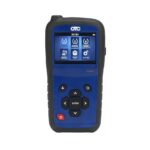The P0430 Obdii code indicates a problem with the catalytic converter’s efficiency on bank two of your engine. This diagnostic trouble code (DTC) specifically signifies that the downstream oxygen sensor in bank two is detecting a performance issue below the acceptable threshold. Understanding this code is crucial for maintaining your vehicle’s emissions system and overall performance.
A properly functioning catalytic converter is vital for reducing harmful emissions. It converts toxic gases like carbon monoxide into less harmful substances like carbon dioxide. When the P0430 code appears, it suggests the converter isn’t performing this task efficiently, potentially leading to increased pollution and possible vehicle performance issues. The problem might lie with the catalytic converter itself or with the oxygen sensor providing the data.
Common Symptoms of a P0430 Code
While a P0430 code might not always result in noticeable drivability problems, there are some common indicators to watch for:
- Check Engine Light: The most obvious sign is the illumination of the check engine light on your dashboard. This signals a detected issue within the engine’s systems.
- Rough Idle: In colder temperatures, a damaged or inefficient catalytic converter can cause the engine to idle roughly or unevenly.
- Increased Exhaust Noise: While less common with a P0430 specifically, an exhaust leak, which can sometimes trigger this code, may result in a louder or unusual exhaust sound. This is due to exhaust gases escaping before reaching the muffler.
- Reduced Fuel Efficiency: A malfunctioning catalytic converter can impact fuel economy, though this might be subtle and not always easily noticeable.
Potential Causes of a P0430 Code
Several issues can trigger a P0430 code. Diagnosing the root cause requires a systematic approach:
- Exhaust Leaks: Any leaks in the exhaust system, especially before the downstream oxygen sensor, can disrupt the sensor readings and trigger the P0430 code. Cracks, rust, or loose connections are common culprits.
- Faulty Oxygen Sensor: A malfunctioning or dirty downstream oxygen sensor in bank two can provide inaccurate readings to the engine control module (ECM), leading to a false or legitimate P0430 code.
- Damaged or Clogged Catalytic Converter: The most common cause is a damaged or clogged catalytic converter. Over time, the internal honeycomb structure can become coated with deposits, reducing its effectiveness and triggering the code.
Solutions for a P0430 Code
Addressing a P0430 code requires pinpointing the underlying issue:
- Exhaust System Repair: If leaks are detected, repair or replace the affected exhaust components. This might involve welding, patching, or replacing entire sections of the exhaust pipe.
- Oxygen Sensor Replacement: If the oxygen sensor is faulty, dirty, or damaged, replacement is typically the solution. Ensure the correct sensor type is used for your specific vehicle.
- Catalytic Converter Replacement: A failing catalytic converter usually necessitates replacement. While sometimes cleanable, replacement is often the most effective long-term solution. Choose a quality replacement that meets your vehicle’s specifications.
After any repair, clear the code with an OBDII scanner and monitor the vehicle to ensure the code doesn’t reappear.
Addressing the P0430 OBDII Trouble Code
A P0430 code requires prompt attention to minimize potential damage and maintain vehicle emissions compliance. While often pointing to a catalytic converter issue, thorough diagnostics are crucial to identify the exact cause and implement the appropriate solution. Addressing the issue quickly helps prevent further damage and ensures your vehicle runs efficiently and cleanly.

